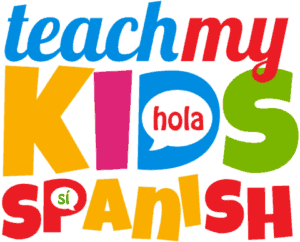
It can be easy to sit your kids down in front of the TV to learn a new language or drop them off at school, but that doesn’t help you or I learn Spanish (the parents!) with them. So, what are some ways that you and your kids can learn Spanish together? Below are some tips, tricks, and ideas that I researched for how you and your kids can learn Spanish as a family.
What are some fun ways to learn Spanish as a family?
- Go on Vacation to a Spanish speaking country
- Move to a Spanish Speaking Country
- Go to Dinner or Make Dinner at Home
- Turn Everyday Excursions into language lessons
- Sings Spanish Songs Together
- Read Spanish Books Together
- Learn Spanish by Topics
- Watch Movies or Shows in Spanish
- Go to Local Community Events
- Play “I Spy” on Walks or Drives
- Label the House with Sticky Notes
- Fire Hose Word Practice
- Water a Sight Word Garden
- Play with the Word Building Travel Kit
- Play 20 Questions
Let’s dive into these tips and tricks a little deeper!
How To Learn Spanish as a Family Together
There are many great ways to learn Spanish as a family. The best ways to learn always involve having fun and engaging with other people. Try to be a little more focused on interacting and engaging, instead of putting your nose in a book. The more fun we have, the more engaged we will be!
Now, let’s explore each of the ways that we can learn Spanish as a family.
1. Move to a Spanish Speaking Country
The first way you can learn Spanish as a family is by moving to a Spanish speaking country. I know, I know . . . this could be a little more than you were initially planning to do, but let’s think about the benefits first.
So, the benefits of moving to a Spanish speaking country like Colombia or Spain are that you will be fully immersed in the language and culture. Studies have found that being immersed in a language and culture dramatically helps you learn a new language quickly.
Think about it . . . when you are struggling to understand what people are saying to you and your kids, or you are trying to ask for something in Spanish, you will be rapidly learning a new language.
As long as you and your family decide to be a part of the local language and culture, then you will learn Spanish.
2. Go on Vacation to a Spanish Speaking Country

I realize that moving to a Spanish speaking country is not an option for most people, so this next idea may be more your speed! Take a vacation to a Spanish speaking country!
This is another great way to plunge head-first into the language and culture of Spanish speaking countries.
While you are on vacation, you will have the opportunity to visit and communicate with locals about politics, food, culture, and tourist spots. Another benefit is that you and your family will grow to appreciate the local culture.
Here is a list of the countries where Spanish is the official language.
- Argentina
- Bolivia
- Chile
- Colombia
- Costa Rica
- Cuba
- Dominican Republic
- Ecuador
- El Salvador
- Equatorial Guinea
- Guatemala
- Honduras
- Mexico
- Nicaragua
- Panama
- Paraguay
- Peru
- Puerto Rico
- Spain
- Uruguay
- Venezuela
3. Go to Dinner or Make Dinner at Home
Do you like Mexican food? Or do you have a local Spanish restaurant nearby? Family dinner dates to your local Mexican or Spanish restaurant can be a lot of fun! You can learn about the food with your kids and eat traditional Mexican and Spanish food.
Recipe for the Perfect Spanish Dinner Night
If you want to get a little more creative, then you can make food at home with the family to learn more about the food and culture. For fun, I have come up with the perfect Spanish dinner night with links to recipes.
Drink: Tinto De Verano (or non-alcoholic Sangria for the kids)

When you think of Spanish drinks, your initial thought will most likely be to make some sangria. While sangria is a Spanish drink, it is mostly for tourists. What Spaniards drink on a regular basis is “tinto de verano”, which translates to “red wine of summer”.
For the adults at the dinner party, here is a simple recipe for tinto de verano. For the kids, we have a non-alcoholic sangria recipe for them to enjoy.
Appetizer: Tapas
Nothing better says Spanish food than when you are sharing and eating tapas. For those that don’t know, a tapa is a snack or appetizer in Spanish cuisine that is generally small and can be shared with a group. Some of my favorite tapas are Tortilla Española (“Spanish Omelette”) and Patatas Bravas (“Brave Potatoes”). If you want to expand your knowledge of the different types of tapas, here is a link to more dishes.
Tortilla Española
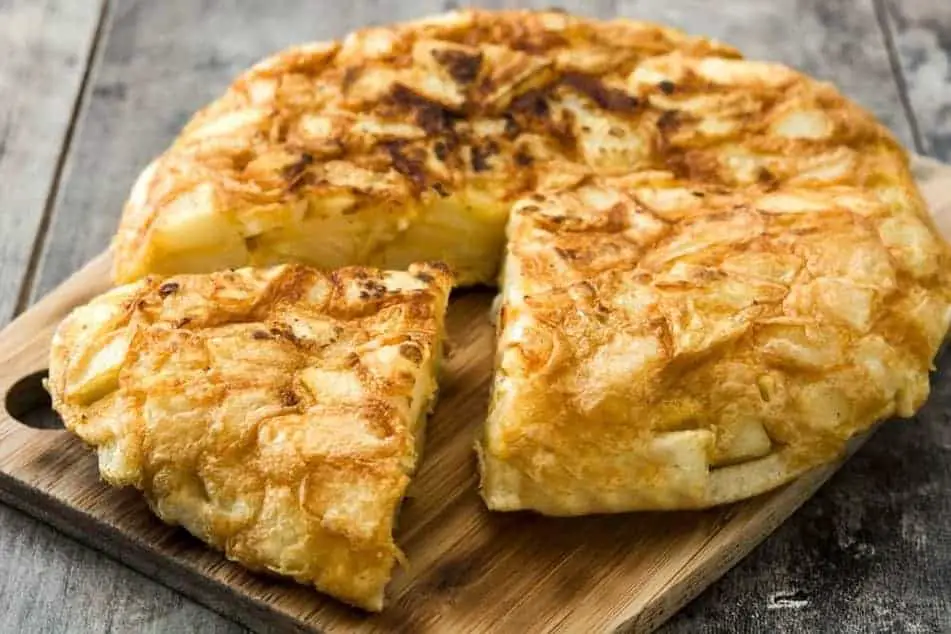
This is my favorite dish of Spanish cuisine. I could eat it for breakfast, lunch, or dinner. Tortilla Española, or Spanish Omelette, is a mixture of eggs and potatoes with the option to include onions and/or little bits of Spanish ham.
The eggs and potatoes are mixed together and cooked on a skillet. Once the dish is completely cooked, it will look like an egg and potato pizza.
Here is a recipe for how to make this fantastic dish! I am still trying to perfect how to cook this dish. Sometimes we have too many potatoes. Other times we cook it too long. However, it is still very tasty even though we have not mastered how to make it!
Patatas Bravas
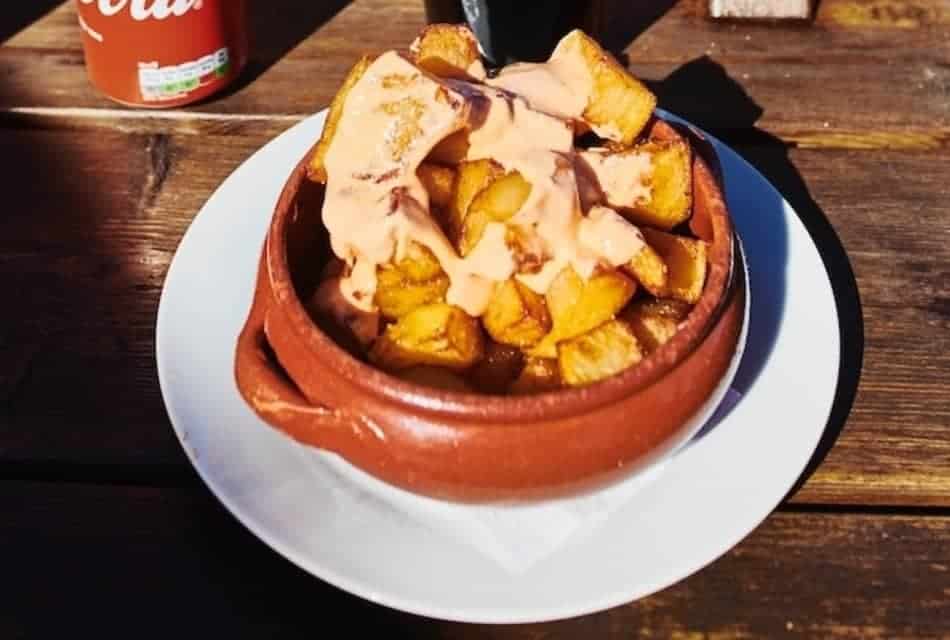
This is also an incredibly tasty tapa! This dish consists of white potatoes cut into roughly 2 centimeters cubes, then fried and served with a spicy sauce. I love it when they serve it with the spicy sauce and drizzle aioli on top.
Here is an easy recipe for how to make patatas bravas.
Main Entree: Paella
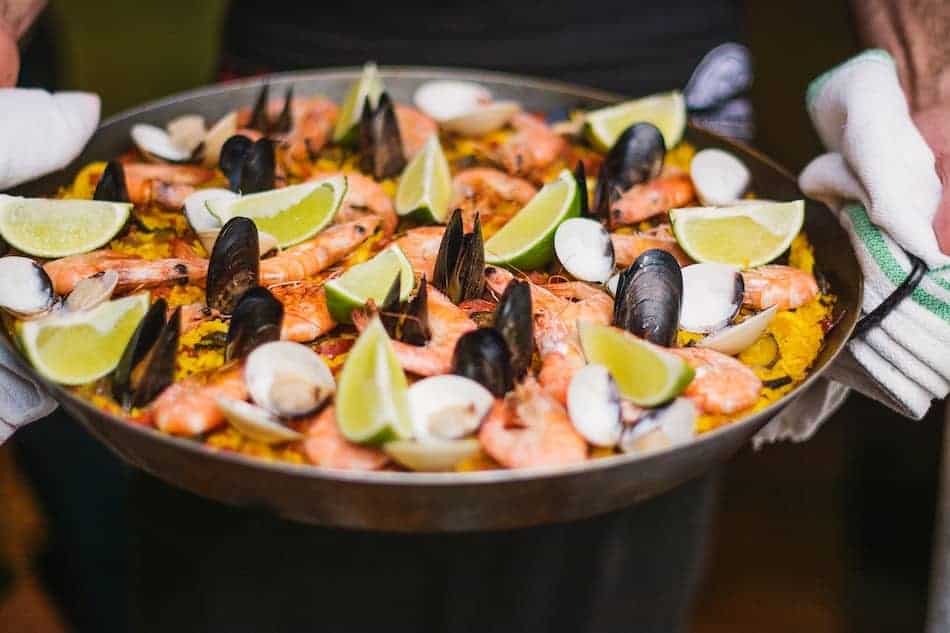
Now, it is time for the main course! Paella is a Spanish rice dish that originates from Valencia, Spain. This may be the most well-known dish in Spain. Paella is cooked in a shallow wide pan and typically consists of rice, a vegetable such as green beans, and a protein of either chicken or seafood.
Here is a recipe you can use to make paella at home.
Dessert: Churros
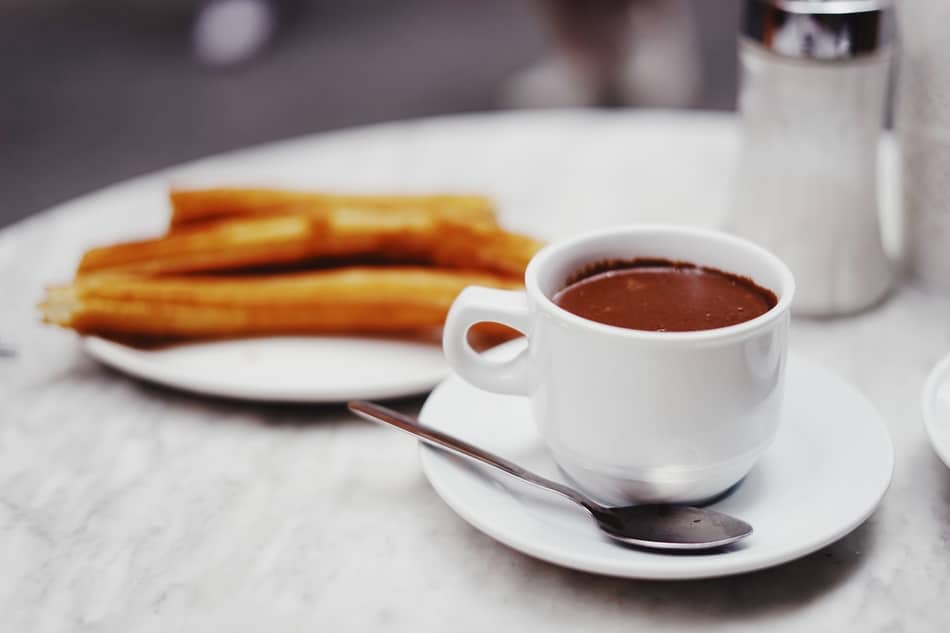
Last, but not least, we get to savor some delicious churros. Churros are a fried-dough pastry that can be sprinkled in sugar. One of the popular ways to eat them in Spain is by dipping them in liquid hot chocolate!
Here is a delicious recipe for how to make churros with hot chocolate.
4. Turn Everyday Excursions into Language Lessons
Sometimes we over-think it. Make learning Spanish as simple and easy as possible.
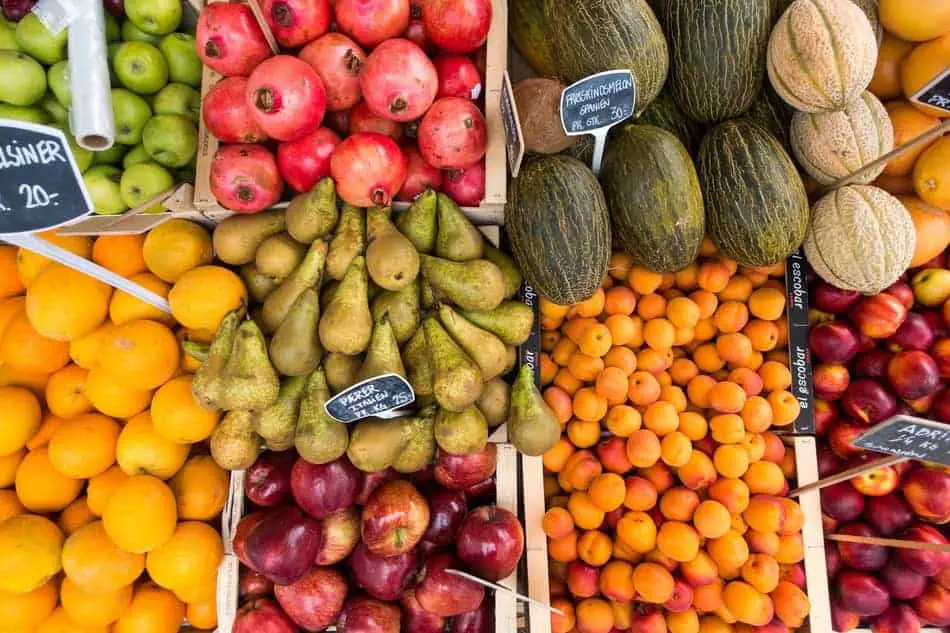
For example, when you go to the grocery store with your kids try to name as many fruits and vegetables as possible. Make it fun! Make it a game! Maybe the person who names the most food items gets a treat from the check-out line.

Here is another example. Take a trip to the zoo and name as many animals as possible. Kids love to see the animals and then make the noises that they have already learned. Often times, I will ask my daughter, “What sound does a león make?” and then she will respond with “Roarrrr!”. That can go on for a while with the sounds of monkeys, gorillas, horses, etc.
5. Sing Spanish Songs Together
Little kids love singing songs! Try singing some of their favorite songs in Spanish, like Old MacDonald, Baby Shark, and Head Shoulders Knees and Toes.
Old MacDonald Had A Farm (El Viejo MacDonald Tenia Una Granja)
Baby Shark (Bebé Tiburón)
Head Shoulders Knees and Toes (Cabeza Hombros Rodillas y Pies)
If you want more recommendations or snippets of songs, check out our Songs Resources page here.
6. Read Spanish Books Together

Reading together is another great way to learn Spanish as a family. I know that my daughter absolutely loves me reading to her, so I try to read to her in Spanish when I can. After the fifth or sixth time of reading through the book (Yes, these kids can make us read them all in one night!) I start learning new words myself. And, of course, the best way to learn a new language is through repetition.
Here is a link to my favorite Spanish books to read with my family.
7. Focus on Learning Spanish by Topics
Another way to learn Spanish together as a family is by trying to learn Spanish based upon different topics. For example, you can learn about vegetables, fruit, numbers, colors, farm animals, wild animals, family members, friends, travel, etc.
Below are some words you can try in each of these different topics:
Vegetables
- Verduras = Vegetables
- Brócoli = Broccoli
- Zanahoria = Carrot
- Papa = Potato
- Tomate = Tomato
Fruit
- Fruta = Fruit
- Manzana = Apple
- Plátano = Banana
- Limón = Lemon
- Naranja = Orange
- Pera = Pear
Numbers
- Numeros = Numbers
- Cero = Zero
- Uno = One
- Dos = Two
- Tres = Three
- Cuatro = Four
- Cinco = Five
- Seis = Six
- Siete = Seven
- Ocho = Eight
- Nueve = Nine
- Diez = Ten
Colors
- Colores = Colors
- Rojo = Red
- Rosado = Pink
- Marron = Brown
- Morado = Purple
- Amarillo = Yellow
- Azul = Blue
- Verde = Green
- Blanco = White
- Negro = Black
Animals
- Animales = Animals
- Gato = Cat
- Perro = Dog
- Pájaro = Bird
- Vaca = Cow
- Caballo = Horse
- Pollo = Chicken
- Cerdo = Pig
8. Watch Movies or Shows in Spanish
There are some incredible Spanish movies and shows that you can find. Look in places like Netflix, Disney+, Hulu, Youtube, and Amazon Prime.
COCO
This is the COCO trailer for the Spanish version of the film. You can find the full movie on Disney+.
Puffin Rock
This is another Spanish kids show named Puffin Rock that you can find on Netflix.
For more of my favorite Spanish movies and shows, click on this link.
9. Go to Local Spanish Community Events
The best way to learn a language is to immerse yourself in the language and the culture. If you are not able to live in a Spanish speaking country, then try to find ways that you can communicate with fluent Spanish speakers. One of the ways to speak with native Spanish speakers is by attending local community events.
By attending local community events you should be able to practice your Spanish and learn more about the culture. Some events may be for Cinco de Mayo held annually on May 5 to celebrate Mexico’s victory over the French Empire in 1862. Another event may be for Dia de Los Muertos (Day of the Dead) held annually from October 31 to November 2 where people come together to remember family and friends who have died.
10. Play “I Spy” on Walks or Drives
Have you ever played a little game called “I Spy”? If not, you and your kids may be in for a treat.
The game is with two or more people. One person acts as the spy. As the spy, you silently pick an object but make sure you don’t tell the other players. Next, you give a clue description of the object by saying something like“Espío con mi pequeño ojo algo azul”, which translates to “I spy with my little eye something blue.” Then, the other players try to guess the object. If they can’t guess the object, give them more hints.
The larger your Spanish vocabulary, the more fun you will have. I suggest that each person takes a turn as the spy. See how many words you can use in Spanish to describe the objects.
Here is a video with a run-down on the game, I Spy.
11. Label Items Around the House
Have you ever tried labeling items so that you remember them? If yes, I bet it worked!
To help learn Spanish, label all sorts of items around your house so that you and your family can learn new words. Don’t label just a couple things . . . LABEL EVERYTHING! The amount of things you can label should be overwhelming. You can learn tons of vocabulary just by creating these labels! Try it!
12. Play Fire Hose Word Practice
Does this header seem a little sketchy? Don’t over-think this either. Kids love games and they love games with water! Even better, add a hose!
So, how you play the game is by taking some chalk or dissolvable markers outside. Write some Spanish words and phrases on the concrete or fence. Or write in different colors so that the little kids can find the different colors. After you are finished writing the words, phrases or colors, starting asking your kids questions. The answers should be in chalk or markers on the concrete/fence. When they answer a question, they spray the concrete with water!
Games like these where kids are having fun and being engaged is one of the best ways for them to learn.
13. Water a Sight Word Garden
This is another game similar to fire hose word practice. Here, have your kids draw a beautiful chalk garden full of words or objects they know or are learning. Then, have your kids read the words or make an association with the objects. Once that is completed, have them wash away the chalk garden.
14. Play Word Building Travel Kit
What an amazing idea for summer traveling! Grab a fun lunch box and magnetic letters, and then let the word building begin.
How this works is that you buy an old-school metal lunch box and several magnetic letters. The lunch box will keep the magnetic letters in once place and also serve as a surface where your kids can spell different words.
Throw different Spanish words at your kids and have them spell the words! Get fun and be creative! Kids will love moving the magnets around on the lunch box.
15. Play 20 Questions
Have you ever played 20 Questions? Have you ever played 20 Questions in Spanish?
This game is easy to adapt to language learning. For simplicity, limit the word to the vocabulary that you already know. For example, if your kids know fruits and vegetables, then limit the words to those categories. This can be a fun way to engage your kids and continue learning vocabulary.
Here are the steps for how to play the game.
First, player 1 thinks of an object. You can also give the other players a classification of the object, such as animal, vegetable, mineral, etc. If you are limiting the word to only the vocabulary that you know, then let the players know that ahead of time.
Second, have another player ask Yes or No questions to learn more about the mystery object. Then, Player 1 answers Yes or No to each question.
Third, have the other players continue asking Player 1 Yes or No questions up to a total of 20 questions.
Fourth, players are able to guess the object any time in the form of a question. That question will count towards the 20 question total.
Fifth, have the players guess the mystery object. The winner will be the one that correctly guesses the mystery object.
